
Roswell is a city in northern Fulton County, Georgia, United States. It is an affluent northern suburb of the state capital of Atlanta. Roswell is Georgia's eighth largest city with a population of 88,346 per the 2010 United States Census.
History

Vickery (Big) Creek Dam
In 1830, while on a trip to North Georgia, Roswell King passed through the area of what is now Roswell and observed the great potential for building a cotton mill along Vickery Creek. Since the land nearby was also good for plantations, his idea was to put cotton processing near cotton production.
Toward the middle of the 1830s, King returned to build a mill that would soon become the largest in North Georgia – Roswell Mill. He brought with him 36 African slaves from his own coastal plantation, plus another 42 skilled carpenter slaves bought in Savannah to build the mills. The slaves built the mills, infrastructure, houses, mill worker apartments, and supporting buildings for the new town. The Africans brought their unique Geechee culture, language, and religious traditions from the coast to north Georgia.
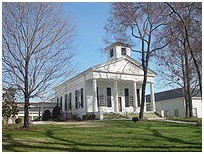
The old Roswell Presbyterian Church, built in 1839.
King invited investors from the coast to join him at the new location. He was also joined by Barrington King, one of his sons, who succeeded his father in the manufacturing company. Archibald Smith was one of the planters who migrated there to establish a new plantation, also bringing enslaved African Americans from the coastal areas.
Barrington Hall (the home of Barrington King), Smith Plantation (the home of Archibald Smith) and Bulloch Hall (The childhood home of President Theodore Roosevelt's mother – Mittie Bulloch) have been preserved and restored. They are now open to the public. According to the 1850 Slave Schedules, these three "founding families", together with the next three largest planters, held 192 slaves, 51% of the total 378 slaves held in Roswell District. Archibald Smith had a 300-acre (1.2 km2) cotton plantation. According to the 1850 Census, Barrington King held 70 slaves. Half of these slaves were under the age of 10. These slaves worked in Barrington's household. Barrington King "leased" or "rented" some of his adult male slaves to the Roswell Manufacturing Company but they did not work around the mill machinery.
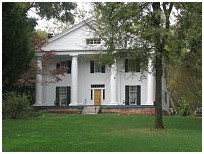
Bulloch Hall, built in 1839.
The Roswell area was part of Cobb County when first settled, and the county seat of Marietta was a four-hour (one-way) horseback ride to the west. Since Roswell residents desired a local government, they submitted a city charter for incorporation to the Georgia General Assembly. The charter was approved on February 16, 1854.
By the time of the Civil War, the cotton mills employed more than 400 people, mostly women. Given settlement patterns in the Piedmont, they were likely of Scots-Irish descent. As the mill increased in production, so did the number of people living in the area.
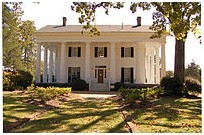
Barrington Hall, built in 1842.
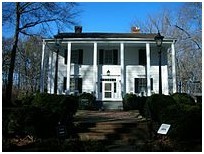
Archibald Smith Plantation Home, built in 1845.
During the American Civil War, the city was captured by Union forces under the leadership of General Kenner Garrard. Under orders of General Sherman, Garrard shipped the mill workers north to prevent them from returning to work if the mills were rebuilt. This was a common tactic of Sherman to economically disrupt the South. The mill was burned, but the houses were left standing. The ruins of the mill and the 30-foot (9.1 m) dam that was built for power still remain. Most of the town's property was confiscated by Union forces. The leading families had left the town to go to safer places well before the Federal invasion, and arranged for their slaves to be taken away from advancing Federal troops, as was often the practice. Some slaves may have escaped to Union lines.
After the war, Barrington King rebuilt the mills and resumed production. While many freedmen stayed in the area to work as paid labor on plantations or in town, others migrated to Fulton County and Atlanta for new opportunities. The South suffered an agricultural depression resulting from the effects of the war and labor changes.
According to the census, the population of Cobb County decreased slightly from 14,242 in 1860, to 13,814 in 1870. The proportion of African-Americans decreased more, from 27% to 23%. During those years, nearby Fulton County more than doubled in population, from 14,427 to 33,336. The effects of dramatic African-American migration can be seen by the increase in Fulton County from 20.5% slave in 1860 to 45.7% colored (Black) in 1870.
At the end of 1931, the United States was in the midst of the Great Depression. The difficult economic conditions drove Milton County, Roswell's neighboring county to the north (note: much of what is now Roswell was part of Milton county already), to merge in its entirety with Fulton County, Roswell's neighboring county to the south. To facilitate the merger, Roswell was ceded by Cobb County to Fulton. Sections of neighboring Cherokee and Gwinnett counties were also ceded to Fulton at this time to define the expanded and contiguous northern section of Fulton County.
Roswell is now one of the largest cities in the state; its population has increased most steadily in the last 15 years.
Jere Wood, a Republican, has served as mayor of Roswell since 1997.
Geography
Roswell is located at
34°2′2″N 84°20′39″W34.03389°N 84.34417°W (34.033896, −84.344028).
According to the United States Census Bureau, the city has a total area of 38.6 square miles (100 km2), of which, 38.0 square miles (98 km2) of it is land and 0.6 square miles (1.6 km2) of it (1.53%) is water.
Geographic features
• Big Creek
• Bull Sluice Lake
• Chattahoochee River
• Morgan Falls Dam
• Johns Creek
• Crooked Creek
• Audery Mill Creek
Major highways
• State Route 9
• State Route 92
• State Route 120
• State Route 140
• State Route 400
Climate
Customary
| Month | Jan | Feb | Mar | Apr | May | Jun | Jul | Aug | Sep | Oct | Nov | Dec | Year |
| Avg high (°F) | 49.0 | 53.8 | 62.8 | 71.5 | 78.2 | 84.6 | 87.3 | 86.7 | 81.2 | 71.8 | 62.6 | 53.0 | 70.2 |
| Avg low (°F) | 27.0 | 29.4 | 36.4 | 44.2 | 53.0 | 60.9 | 65.1 | 64.6 | 58.6 | 45.6 | 37.3 | 30.3 | 46.0 |
| Rainfall (in) | 5.2 | 4.9 | 6.0 | 4.6 | 4.7 | 3.7 | 4.8 | 4.1 | 3.6 | 3.5 | 3.8 | 4.8 | 53.8 |
Metric
| Month | Jan | Feb | Mar | Apr | May | Jun | Jul | Aug | Sep | Oct | Nov | Dec | Year |
| Avg high (°C) | 9.4 | 12.1 | 17.1 | 21.9 | 25.7 | 29.2 | 30.7 | 30.4 | 27.3 | 22.1 | 17.0 | 11.7 | 21.2 |
| Avg low (°C) | -2.8 | -1.4 | 2.4 | 6.8 | 11.7 | 16.1 | 18.4 | 18.1 | 14.8 | 7.6 | 2.9 | -0.9 | 7.8 |
| Rainfall (mm) | 132 | 124 | 152 | 117 | 119 | 94 | 122 | 104 | 91 | 89 | 97 | 122 | 1367 |
Demographics
| Historical populations | |||
| Census | Pop. | %± | |
| 1880 | 1,180 | — | |
| 1890 | 1,138 | −3.6% | |
| 1900 | 1,329 | 16.8% | |
| 1910 | 1,158 | −12.9% | |
| 1920 | 1,227 | 6.0% | |
| 1930 | 1,432 | 16.7% | |
| 1940 | 1,622 | 13.3% | |
| 1950 | 2,123 | 30.9% | |
| 1960 | 2,983 | 40.5% | |
| 1970 | 5,430 | 82.0% | |
| 1980 | 23,337 | 329.8% | |
| 1990 | 47,923 | 105.4% | |
| 2000 | 79,334 | 65.5% | |
| 2010 | 88,346 | 11.4% | |
As of 2010 Roswell had a population of 88,346. The racial and ethnic composition of the population was 74.7% white, 11.7% black or African American, 1.5% Asian Indian, 2.5% other Asian, 0.3% Native American, 0.1% Pacific Islander, 6.6% from some other race and 2.5% from two or more races. 16.6% of the population was Hispanic or Latino of any race.[6]
As of the census[2] of 2000, there were 79,334 people, 30,207 households, and 20,933 families residing in the city. The population density was 2,086.5 people per square mile (805.7/km²). There were 31,300 housing units at an average density of 823.2 per square mile (317.9/km²). The racial makeup of the city was 81.51% White, 8.54% African American, 0.20% Native American, 3.74% Asian, 0.03% Pacific Islander, 4.08% from other races, and 1.90% from two or more races. Hispanic or Latino of any race were 10.61% of the population.
There were 30,207 households out of which 34.6% had children under the age of 18 living with them, 57.1% were married couples living together, 8.6% had a female householder with no husband present, and 30.7% were non-families. 23.1% of all households were made up of individuals and 4.5% had someone living alone who was 65 years of age or older. The average household size was 2.61 and the average family size was 3.07.
In the city the population was spread out with 24.4% under the age of 18, 8.2% from 18 to 24, 35.1% from 25 to 44, 24.7% from 45 to 64, and 7.5% who were 65 years of age or older. The median age was 37.2 years. For every 100 females there were 100.0 males. For every 100 females age 18 and over, there were 98.0 males.
According to a 2007 estimate, the median income for a household in the city was $73,469, and the median income for a family was $103,698. The average income for households was $106,219 and the average income for families was $123,481. Males had a median income of $72,754 versus $45,979 for females. The per capita income for the city was $40,106. About 3.2% of families and 5.0% of the population were below the poverty line, including 5.6% of those under age 18 and 0.7% of those age 65 or over.
Household Income (2005)
| Income | Percent |
| under $14,999 | 3.9% |
| $15,000 – $34,999 | 17.8% |
| $35,000 – $74,999 | 32.2% |
| $75,000 – $99,999 | 11.8% |
| $100,000 – $149,999 | 14.3% |
| $150,000 – $199,999 | 8.6% |
| $200.000 + | 11.4% |
Household Income (2005)
| Median | $84,595 |
| Per Capita | $37,667 |
| Mean | $99,961 |
| Average Family Size | 3.53 |
| Average Household Size | 2.91 |
Roswell Median Housing Value
| Year | Value |
| 1990 | $143,497 |
| 2000 | $207,700 |
| 2005 | $299,000 |
2000 Population by Age
| Age | Percent |
| Under 5 | 6.8% |
| 5–9 | 7.9% |
| 10–19 | 12.7% |
| 20–29 | 9.8% |
| 30–39 | 19.4% |
| 40–49 | 17.2% |
| 50 -59 | 13.9% |
| 60–69 | 5.5% |
| 70 and over | 4.4% |
| Not Known | 2.4% |
| Median Age | 37.2 |
Population by Gender (2006)
| Gender | Percent |
| Male | 49.2% |
| Female | 50.8% |
Education
| Level | Percent |
| Less than High School | 16.1% |
| High School Graduate | 21.1% |
| Associate's Degree | 43.9% |
| Bachelor's Degree | 18.9% |
Race & Ethnicity
| Ethnicity | Percent |
| American Indian, Eskimo, Aleut | 0.9% |
| Asian | 4.4% |
| Black | 12.4% |
| White | 73.9% |
| Other | 6.3% |
| Hispanic | 14.8% |
CNN named Roswell #76 for its list of the Top 100 Places to Live in the US in 2010.
Named One of the Top Three Cities in the Nation to Raise Your Family. Roswell was listed third in the book, Best Places to Raise Your Family, released by Frommer's.
On October 30, 2006, the City of Roswell was named the 18th Safest City in the United States by City Crime Rankings, an annual reference book of crime statistics and rankings published by Morgan Quitno Press. Roswell was selected from 371 cities in the Overall Safest 25 category.
Economy
The Consulate-General of Honduras in Atlanta is located at Suite 3 in 600 Houze Way in Roswell.[11]
Points of interest
• Archibald Smith Plantation Home
• Bulloch Hall
• Barrington Hall
• Chattahoochee River National Recreation Area
• Chattahoochee Nature Center
• Faces Of War Memorial
• Primrose Cottage
• Teaching Museum North
• Atlanta Rowing Club
• Holly Hill
• Historic Roswell District
Parks and recreation
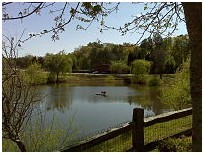
Pond at East Roswell Park
The Roswell Recreation and Parks department has 18 parks with 800 acres (3.2 km2) of active and passive parkland and facilities. The goals of the department are to promote a sense of community spirit and athleticism in the youth of Roswell partnering with many local middle and high schools to achieve its goals by lending practice fields and athletic coaches throughout the year.
A branch of the Chattahoochee River National Recreation Area, a component of the National Park System, is located in Roswell at Vickery Creek.
Notable festivals and parades
• Roswell Memorial Day Ceremony — the largest Memorial Day Ceremony in Georgia
• Roswell Roots: A Festival of Black History & Culture (February)
• Roswell Criterium Bicycle Race and Historic Roswell Kiwanis Kids Bike Safety Rodeo (May)
• Roswell Magnolia Storytelling Festival (June)
• Riverside Sounds Concert Series (May — October)
• Roswell Youth Day Parade and Festival (October)
• Keep Roswell Beautiful Duck Race (October)
• Roswell Annual Fireworks Extravaganza July 4
Notable persons and groups from Roswell
Martha Bulloch Roosevelt, the mother of Theodore Roosevelt (the 26th US President) and grandmother of Eleanor Roosevelt, came from Roswell. Bulloch Hall was her home. Emily Dolvin, the aunt of Jimmy Carter (the 39th U.S. President), lived in Roswell the majority of her life and was the inaugural chairwoman of the Roswell Historical Society. Architect Neel Reid lived in Mimosa Hall and died there in 1926.
Comedian Jeff Foxworthy was a frequent diner at one of Roswell's popular bars, The Southern Skillet, when he lived there off and on in the '90s. Former two-time National League MVP Atlanta Braves Baseball Player Dale Murphy, lived in Roswell in the 1980s.[13] In 2006, Tom Price was re-elected to a second term in the United States House of Representatives to serve as the congressmen from the 6th congressional district of Georgia, the district that encompasses most of Roswell. Natural chef Ford Fry also lives in Roswell.[14]
Georgia Secretary of State Karen Handel resides in Roswell as well as former Pittsburgh Steeler and current NBC Sports announcer Jerome Bettis.



















